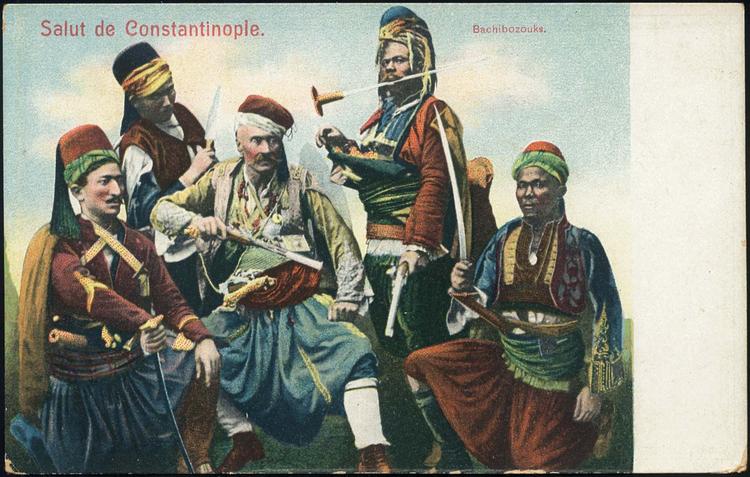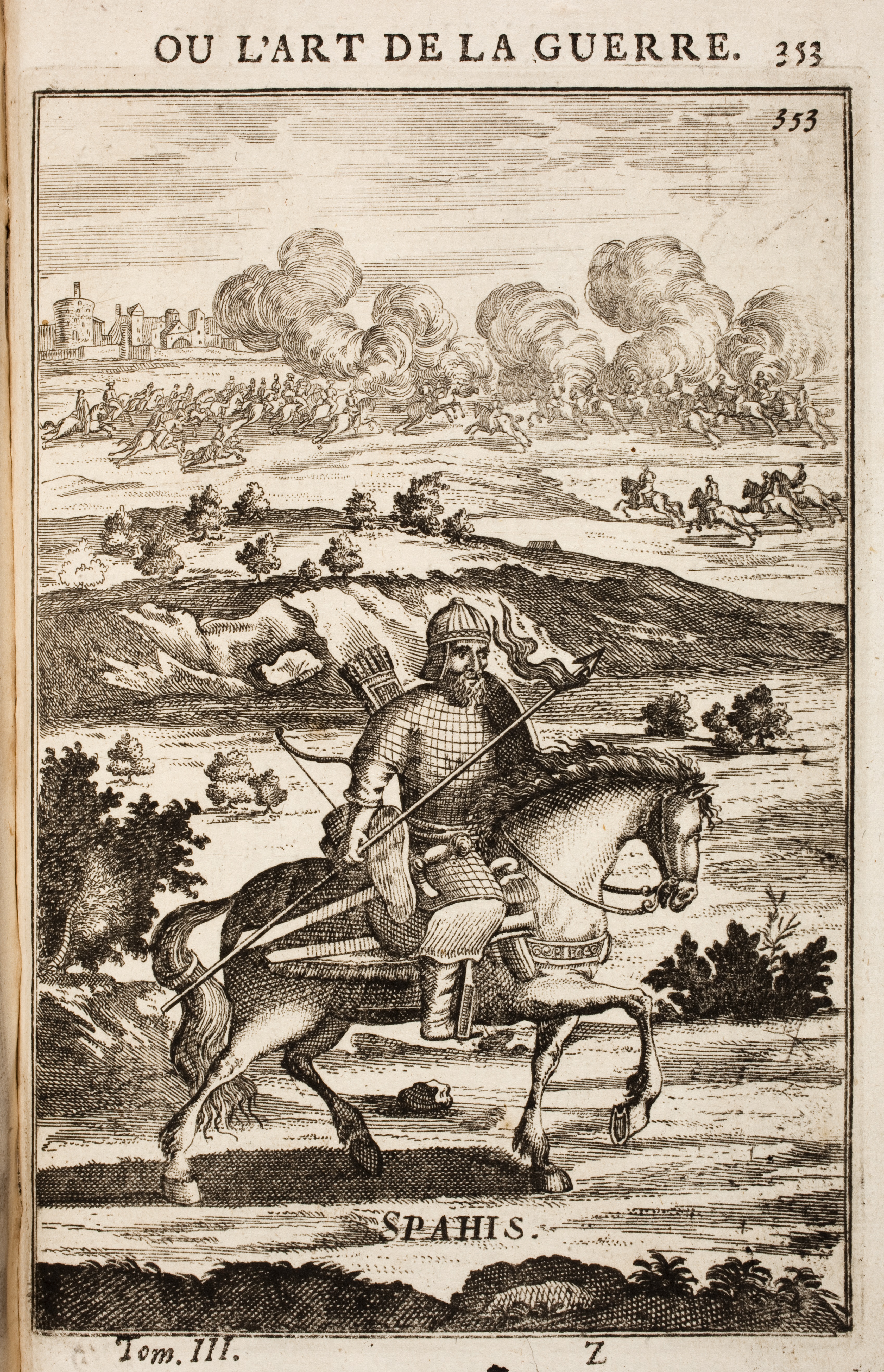|
Bashibazouk
A bashi-bazouk ( ota, باشی بوزوق , , , roughly "leaderless" or "disorderly") was an irregular soldier of the Ottoman army, raised in times of war. The army chiefly recruited Albanians and Circassians as bashi-bazouks, but recruits came from all ethnic groups of the Ottoman Empire including slaves from Europe or Africa. They had a reputation for bravery, but also as an undisciplined and brutal group, notorious for looting and preying on civilians as a result of a lack of regulation and of the expectation that they would support themselves off the land. Origin and history Although the Ottoman armies always contained mercenaries as well as regular soldiers, the strain on the Ottoman feudal system caused mainly by the Empire's wide expanse required heavier reliance on irregular soldiers. They were armed and maintained by the government, but did not receive pay and did not wear uniforms or distinctive badges. They were motivated to fight mostly by expectations of plun ... [...More Info...] [...Related Items...] OR: [Wikipedia] [Google] [Baidu] |
Jean-Léon Gérôme
Jean-Léon Gérôme (11 May 1824 – 10 January 1904) was a French painter and sculptor in the style now known as academicism. His paintings were so widely reproduced that he was "arguably the world's most famous living artist by 1880." The range of his oeuvre included historical painting, Greek mythology, Orientalism, portraits, and other subjects, bringing the academic painting tradition to an artistic climax. He is considered one of the most important painters from this academic period. He was also a teacher with a long list of students. Early life Jean-Léon Gérôme was born at Vesoul, Haute-Saône. He went to Paris in 1840 where he studied under Paul Delaroche, whom he accompanied to Italy in 1843. He visited Florence, Rome, the Vatican and Pompeii. On his return to Paris in 1844, like many students of Delaroche, he joined the atelier of Charles Gleyre and studied there for a brief time. He then attended the École des Beaux-Arts. In 1846 he tried to enter the p ... [...More Info...] [...Related Items...] OR: [Wikipedia] [Google] [Baidu] |
Sipahi
''Sipahi'' ( ota, سپاهی, translit=sipâhi, label=Persian, ) were professional cavalrymen deployed by the Seljuks, and later the Ottoman Empire, including the land grant-holding (''timar'') provincial '' timarli sipahi'', which constituted most of the army, and the salaried regular '' kapikulu sipahi'', or palace troops. However, the irregular light cavalry ("raiders") were not considered to be . The ''sipahi'' formed their own distinctive social classes and were rivals to the Janissaries, the elite infantry corps of the Sultan. It was also the title given to several cavalry units serving in the French and Italian colonial armies during the 19th and 20th centuries (see ). Name The word is derived from fa, سپاهی, translit=sepāhī, meaning "soldier". The term is also transliterated as and ; rendered in other languages as: in Albanian and Romanian, ''sepuh'' (սեպուհ) in Armenian, () in Greek, or in Serbo-Croatian, Bulgarian, and Macedonian (Cyrillic: ... [...More Info...] [...Related Items...] OR: [Wikipedia] [Google] [Baidu] |
Timariot
Timariot (or ''tımar'' holder; ''tımarlı'' in Turkish) was the name given to a Sipahi cavalryman in the Ottoman army. In return for service, each timariot received a parcel of revenue called a timar, a fief, which were usually recently conquered plots of agricultural land in the countryside. Far less commonly, the sultan would grant a civil servant or member of the imperial family a timar. Also non-military timar holders were obliged to supply the imperial army with soldiers and provisions. The timariots provided the backbone of the Ottoman cavalry force and the army as a whole. They were obligated to fight as cavalrymen in the Ottoman military when called upon. The timariots had to assemble with the army when at war, and had to take care of the land entrusted to him in times of peace. When at war, the timariot had to bring his own equipment and in addition a number of armed retainers (''cebelu''). The timariot was granted feudatory with the obligation to go mounted to war and ... [...More Info...] [...Related Items...] OR: [Wikipedia] [Google] [Baidu] |
Janissary
A Janissary ( ota, یڭیچری, yeŋiçeri, , ) was a member of the elite infantry units that formed the Ottoman Sultan's household troops and the first modern standing army in Europe. The corps was most likely established under sultan Orhan (1324–1362), during the Viziership of Alaeddin. Janissaries began as elite corps made up through the devşirme system of child levy, by which Christian Albanians, Romanians, Armenians, Bulgarians, Croats, Greeks and Serbs were taken, levied, subjected to circumcision and conversion to Islam, and incorporated into the Ottoman army. They became famed for internal cohesion cemented by strict discipline and order. Unlike typical slaves, they were paid regular salaries. Forbidden to marry before the age of 40 or engage in trade, their complete loyalty to the Sultan was expected. By the seventeenth century, due to a dramatic increase in the size of the Ottoman standing army, the corps' initially strict recruitment policy was relaxed. Civil ... [...More Info...] [...Related Items...] OR: [Wikipedia] [Google] [Baidu] |
Akinji
Akinji or akindji ( ota, آقنجى, aḳıncı, lit=raider, ; plural: ''akıncılar'') were Irregular military, irregular light cavalry, scout divisions (deli) and advance troops of the Ottoman Empire's Military of the Ottoman Empire, military. When the pre-existing Turkish Ghazi (warrior), ghazis were incorporated into the Ottoman Empire's military they became known as "akıncı." Unpaid, they lived and operated as wikt:raider, raiders on the frontiers of the Ottoman Empire, subsisting on plunder. There is a distinction made between "akıncı" and "deli (cavalry), deli" cavalry. History In war their main role was to act as advance troops on the front lines and demoralise the marching opposing army by using guerrilla tactics, and to put them in a state of confusion and shock. They could be likened to a scythe in a wheat field. They would basically Turkish archery, hit the enemy with arrows. When attacked in melee, they would retreat while still shooting backwards. They could ea ... [...More Info...] [...Related Items...] OR: [Wikipedia] [Google] [Baidu] |
Plunder
Looting is the act of stealing, or the taking of goods by force, typically in the midst of a military, political, or other social crisis, such as war, natural disasters (where law and civil enforcement are temporarily ineffective), or rioting. The proceeds of all these activities can be described as booty, loot, plunder, spoils, or pillage. During modern-day armed conflicts, looting is prohibited by international law, and constitutes a war crime.Rule 52. Pillage is prohibited. ''Customary IHL Database'', (ICRC)/ |
Feudal System
Feudalism, also known as the feudal system, was the combination of the legal, economic, military, cultural and political customs that flourished in medieval Europe between the 9th and 15th centuries. Broadly defined, it was a way of structuring society around relationships that were derived from the holding of land in exchange for service or labour. Although it is derived from the Latin word ''feodum'' or ''feudum'' (fief), which was used during the Medieval period, the term ''feudalism'' and the system which it describes were not conceived of as a formal political system by the people who lived during the Middle Ages. The classic definition, by François Louis Ganshof (1944), François Louis Ganshof (1944). ''Qu'est-ce que la féodalité''. Translated into English by Philip Grierson as ''Feudalism'', with a foreword by F. M. Stenton, 1st ed.: New York and London, 1952; 2nd ed: 1961; 3rd ed.: 1976. describes a set of reciprocal legal and military obligations which existed ... [...More Info...] [...Related Items...] OR: [Wikipedia] [Google] [Baidu] |
Africa
Africa is the world's second-largest and second-most populous continent, after Asia in both cases. At about 30.3 million km2 (11.7 million square miles) including adjacent islands, it covers 6% of Earth's total surface area and 20% of its land area.Sayre, April Pulley (1999), ''Africa'', Twenty-First Century Books. . With billion people as of , it accounts for about of the world's human population. Africa's population is the youngest amongst all the continents; the median age in 2012 was 19.7, when the worldwide median age was 30.4. Despite a wide range of natural resources, Africa is the least wealthy continent per capita and second-least wealthy by total wealth, behind Oceania. Scholars have attributed this to different factors including geography, climate, tribalism, colonialism, the Cold War, neocolonialism, lack of democracy, and corruption. Despite this low concentration of wealth, recent economic expansion and the large and young population make Afric ... [...More Info...] [...Related Items...] OR: [Wikipedia] [Google] [Baidu] |
Europe
Europe is a large peninsula conventionally considered a continent in its own right because of its great physical size and the weight of its history and traditions. Europe is also considered a subcontinent of Eurasia and it is located entirely in the Northern Hemisphere and mostly in the Eastern Hemisphere. Comprising the westernmost peninsulas of Eurasia, it shares the continental landmass of Afro-Eurasia with both Africa and Asia. It is bordered by the Arctic Ocean to the north, the Atlantic Ocean to the west, the Mediterranean Sea to the south and Asia to the east. Europe is commonly considered to be separated from Asia by the watershed of the Ural Mountains, the Ural River, the Caspian Sea, the Greater Caucasus, the Black Sea and the waterways of the Turkish Straits. "Europe" (pp. 68–69); "Asia" (pp. 90–91): "A commonly accepted division between Asia and Europe ... is formed by the Ural Mountains, Ural River, Caspian Sea, Caucasus Mountains, and the Black Sea wit ... [...More Info...] [...Related Items...] OR: [Wikipedia] [Google] [Baidu] |
Circassians
The Circassians (also referred to as Cherkess or Adyghe; Adyghe and Kabardian: Адыгэхэр, romanized: ''Adıgəxər'') are an indigenous Northwest Caucasian ethnic group and nation native to the historical country-region of Circassia in the North Caucasus. As a consequence of the Circassian genocide, which was perpetrated by the Russian Empire in the 19th century during the Russo-Circassian War, most Circassians were exiled from their homeland in Circassia to modern-day Turkey and the rest of the Middle East, where the majority of them are concentrated today. The Unrepresented Nations and Peoples Organization estimated in the early 1990s that there are as many as 3.7 million Circassians in diaspora in over 50 countries. The Circassian language is the ancestral language of the Circassian people, and Islam has been the dominant religion among them since the 17th century. Circassia has been subject to repeated invasions since ancient times; its isolated terrain couple ... [...More Info...] [...Related Items...] OR: [Wikipedia] [Google] [Baidu] |








